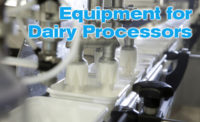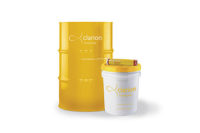Ugly is only skin deep with pumps and valves in food and beverage production. Gunmetal gray and stainless steel skins are the predominant color offerings.
But the inner workings and components can be a thing of beauty. Industry is demanding pumps and valves that are more reliable, robust, efficient and low-maintenance. A premium also is placed on sanitary design, and the makers of pumps and valves are being nudged to meet and often exceed standards such as 3A.
Sanitary clean-in-place (CIP) components help further the goals of process automation, long a priority in food processing. Regulatory hurdles such as the Pasteurized Milk Ordinance (PMO) sometimes work against adoption of the technology that make CIP and automation possible, but sheer doggedness eventually prevails. Such is the case with mix-proof valves, which are starting to be applied in the transfer of large-particulate dairy products.
Engineers at Davisco Foods International Inc. wanted to incorporate mix-proof valves into their process controls for three new cheese vats at the company's Jerome, Idaho, facility. Unfortunately, the PMOs did not recognize any block-and-bleed valves that could handle the cheese curds the system would have to deal with. Rockford, Ill.-based Sudmo North America Inc. accepted the company's challenge to design a valve that could handle large particulate without clogging and then win regulatory approval for the design.
"Because of the PMO requirements, there is an exorbitant amount of valves on the backside of the vats in cheese production," explains Tim Tolley, project engineer at Davisco in Le Sueur, Minn. Besides the cost of the valves themselves, additional controls and other equipment must be capitalized. In Jerome's case, the additional infrastructure required up to 6 feet of floor space to the backside of each vat. Deadhead piping and other redundant equipment clutter the space.
A standard, PMO-approved mix-proof valve clogged up in seconds because of cheese-curd particulate, so Sudmo's engineers adapted a unit with a 4-inch valve. That posed some problems in sizing the leak-detection port. Ultimately, the port was reduced to 2.5 inches to match the CIP port. A 4-inch valve is coupled to a 6-inch body to accommodate particulate flow. FDA authorities reviewed the design and recommended minor modifications, and a year after the project began, the system was up and running.
"We've run them for four months with zero problems," reports Tolley. "We reduced the number of valves on the new vats by six, and there's less need for backflushing of the system." He estimates 10 to 15 lbs. of cheese is backflushed with conventional valve systems. Given the plant's 12 vats, that's a lot of product waste that can be eliminated and fewer housekeeping issues with which to contend. The valves are being incorporated in the $40 million mozzarella plant that Davisco is building in Lake Norden, S.D. That facility is scheduled to come on line in September.
"Davisco pushed us, quite honestly," allows Jack Jordan, president of Sudmo. "Somebody had to sit down and redesign a valve to handle particulate, and that's a big challenge. But the ability to handle particulate up to 1.5 inches opens up complete new markets for us." Fruit for yogurt, soups and pet foods are among the processing segments evaluating the technology.
Tamper-proof valves
Another innovation that must pass sanitary muster before it can find wide application in food processing is the constant flow (CF) valve from GATE LLC. The valve was developed by John Newton, a Florida inventor and founder of Grand Banks Yachts, at the request of E.I. DuPont de Nemours to improve the accuracy of chemical spraying in agriculture. Accurate depositing is easy to achieve if pressure is constant, but that is not always the case. The CF valve offers a simplified design and preset calibration to precisely dispense liquids or gases.
Beverage companies, including a major Florida orange juice producer, are evaluating the valve for use in CIP applications, according to Dennis Richardson. He is president of SSOE Gateway, a Sarasota, Fla., engineering design and construction firm that is helping bring the valve to market. Pressure variation in city water systems is a given, and that raises questions about the efficacy of sanitation washdowns with automated systems. If pressure drops below the preset threshold, the CF valve will automatically shut down, preventing the CIP system from completing its cycle under less than optimal conditions.
"Backpack sprayers for agriculture are the biggest application currently, but the inventor wants to expand applications to food and pharmaceutical," says Richardson. "Being an engineer myself, I saw that the potential uses were very broad. Plant managers and engineers always want to tweak a valve, but because this has a pre-set pressure, it becomes tamper proof."
The first application in the beverage arena is likely to be foodservice. Vendors are notorious for altering the syrup/carbonated water ratios in drink dispensers, a practice that manufacturers abhor.
Before food manufacturers will consider using the valves in depositors and other processing equipment, SSOE Gateway must manufacture a stainless steel version of the valve. "Currently, there are no sanitation issues with the design, but because the food industry is so in tune with food safety, they want a stainless steel body," Richardson explains.
The dairy segment has been the traditional mainstay of pump manufacturers, and sanitary design is a consideration at the outset of any product development.
Pump it up
"Centrifugal pumps have become more robust, with much tighter tolerances and stress analyses of components to increase efficiency and machine time to failure," according to Bruce Smith, North American sales manager for Fristam Pumps Inc., Middleton, Wis. Shaft deflection that results in moving parts hitting stationary components in the pump is a major contributor to pump failure, and manufacturers are addressing that concern.
Liquid ring pumps are coming into play in the industry as an alternative to standard centrifugal pumps, adds Smith. Although these scavenger pumps have been around for a quarter of a century, pharmaceutical manufacturers have embraced the technology and forced redesigns that have expanded their applications. Liquid ring pumps are particularly adept at handling fluids with entrained air, an issue with cream, which tends to foam during transit. Liquid ring pumps do a superior job in fully evacuating a tank, a material-savings advantage that appeals to ice cream manufacturers and liquid egg processors, according to Smith.
Pump improvements have been accelerated with the application of computational fluid dynamics (CFD) software, points out Russell Jones, business development manager-pumps for Alfa Laval in Pleasant Prairie, Wis. "From an R&D point of view, CFD is a big advance in optimizing design and increasing pump efficiency," he says. The technology has been instrumental in boosting pump efficiencies from the 40 percent range to 60 to 70 percent in recent years.
Off-the-shelf CFD software is available from firms such as AEA Technology Engineering Software, a Waterloo, Ont., firm that recently introduced an updated version of its CFX-TASCflow, which features a greatly enhanced cavitation model. Cavitation is the primary cause of pump failure, Jones points out. CFD software was more geared to hydraulic flows in pumps and inducers in turbomachinery when Alfa Laval embraced the technology. The payoff has been centrifugal pumps that create less sheer and can handle some pumping jobs previously reserved for positive displacement pumps.
Consequently, PD pumps have had to be redesigned for improved performance to justify their premium prices. Rotor geometry has been significantly improved for gentle handling of viscous materials with delicate inclusions, such as baked beans and yogurt with fruit. But the greatest technical advancement is CIP-compatible PD pumps. "That is a big leap forward in this industry," Jones says. "This is very sophisticated equipment, machined to within thousandths of an inch, and you don't want to send an army of relatively low-skilled sanitation workers to take apart PD pumps for cleaning and possibly damage them."
Automated cleaning and reduced downtime always have been primary benefits of mix-proof valves, as well, and more dairy processors are beginning to take advantage of the technology thanks to greater acceptance by regulators. "Mix-proof technology has been around for awhile, but the PMO aspect is relatively new," says Mark Ream, business development manager at Alfa Laval, which counts the Tri-Clover brand among its valve offerings. A cleanability hierarchy has been created to accommodate a broad range of products, from fluid milk to sticky, viscous products. Alfa Laval's spiral clean technology represents the company's state-of-the-art CIP for sanitizing the inside of the valve and plug area.


